Consumer Perceptions Towards Food Outlets Displaying Islamic Items
VerifiedAdded on 2020/12/23
|39
|10886
|119
Report
AI Summary
This report, conducted by students from the Faculty of Agro Based Industry, investigates consumer perceptions towards food outlets displaying Islamic items in Malaysia. The study focuses on understanding how factors like halal logos, ownership, materials, and brand influence consumer choices. Utilizing the Knowledge, Attitude, and Perception (KAP) model and the Theory of Planned Behavior (TPB), the research explores the relationship between consumer demographics, attitudes, and perceptions. The findings indicate that specific sub-constructs significantly impact food selection, while ownership factors show less influence. The study recommends increased promotion and publicity of halal certification by JAKIM to enhance positive consumer opinions and raise awareness. The report includes an abstract, literature review, methodology, results, discussion, and conclusions, providing a comprehensive analysis of consumer behavior in the context of halal food choices.
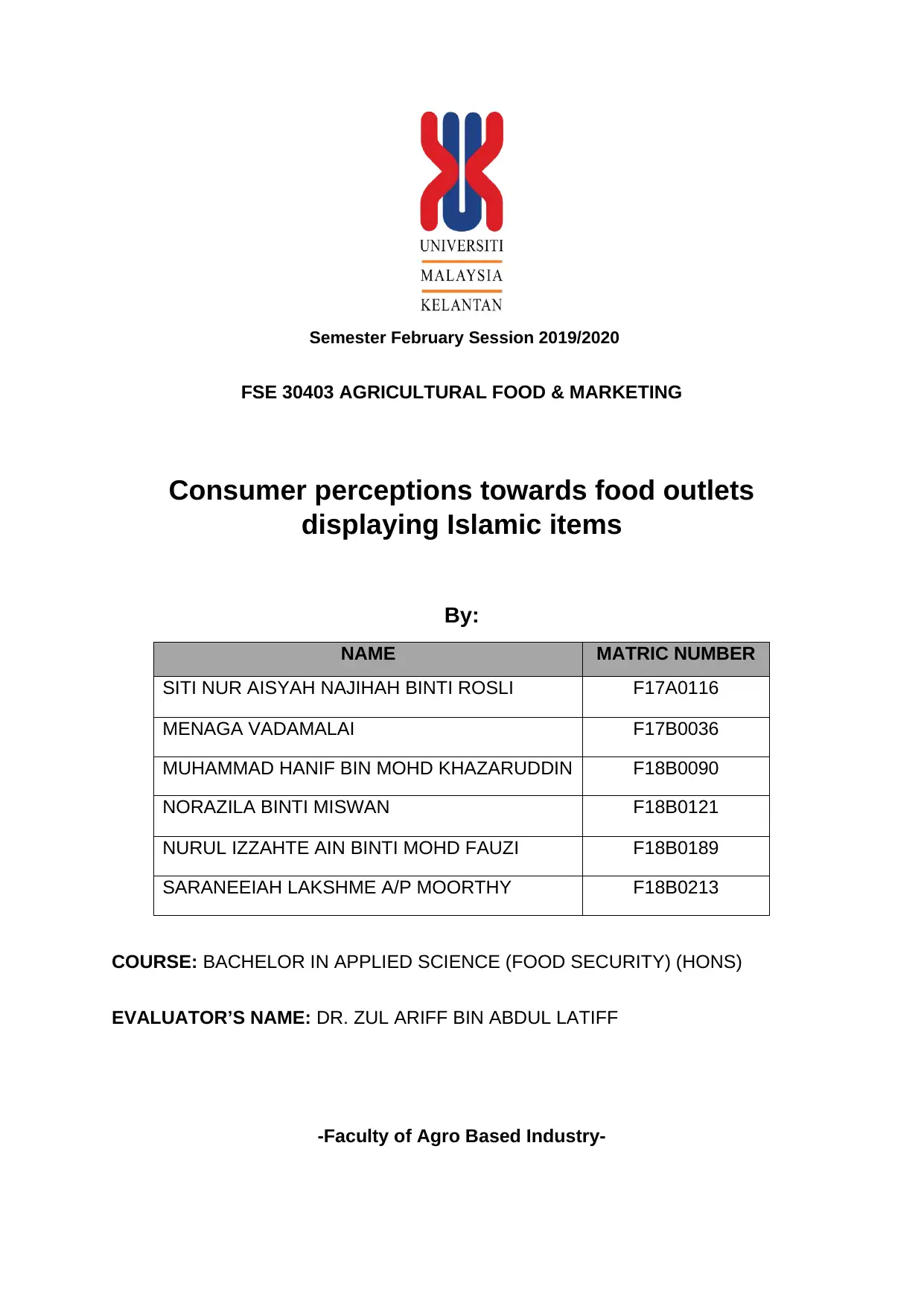
Semester February Session 2019/2020
FSE 30403 AGRICULTURAL FOOD & MARKETING
Consumer perceptions towards food outlets
displaying Islamic items
By:
NAME MATRIC NUMBER
SITI NUR AISYAH NAJIHAH BINTI ROSLI F17A0116
MENAGA VADAMALAI F17B0036
MUHAMMAD HANIF BIN MOHD KHAZARUDDIN F18B0090
NORAZILA BINTI MISWAN F18B0121
NURUL IZZAHTE AIN BINTI MOHD FAUZI F18B0189
SARANEEIAH LAKSHME A/P MOORTHY F18B0213
COURSE: BACHELOR IN APPLIED SCIENCE (FOOD SECURITY) (HONS)
EVALUATOR’S NAME: DR. ZUL ARIFF BIN ABDUL LATIFF
-Faculty of Agro Based Industry-
FSE 30403 AGRICULTURAL FOOD & MARKETING
Consumer perceptions towards food outlets
displaying Islamic items
By:
NAME MATRIC NUMBER
SITI NUR AISYAH NAJIHAH BINTI ROSLI F17A0116
MENAGA VADAMALAI F17B0036
MUHAMMAD HANIF BIN MOHD KHAZARUDDIN F18B0090
NORAZILA BINTI MISWAN F18B0121
NURUL IZZAHTE AIN BINTI MOHD FAUZI F18B0189
SARANEEIAH LAKSHME A/P MOORTHY F18B0213
COURSE: BACHELOR IN APPLIED SCIENCE (FOOD SECURITY) (HONS)
EVALUATOR’S NAME: DR. ZUL ARIFF BIN ABDUL LATIFF
-Faculty of Agro Based Industry-
Paraphrase This Document
Need a fresh take? Get an instant paraphrase of this document with our AI Paraphraser
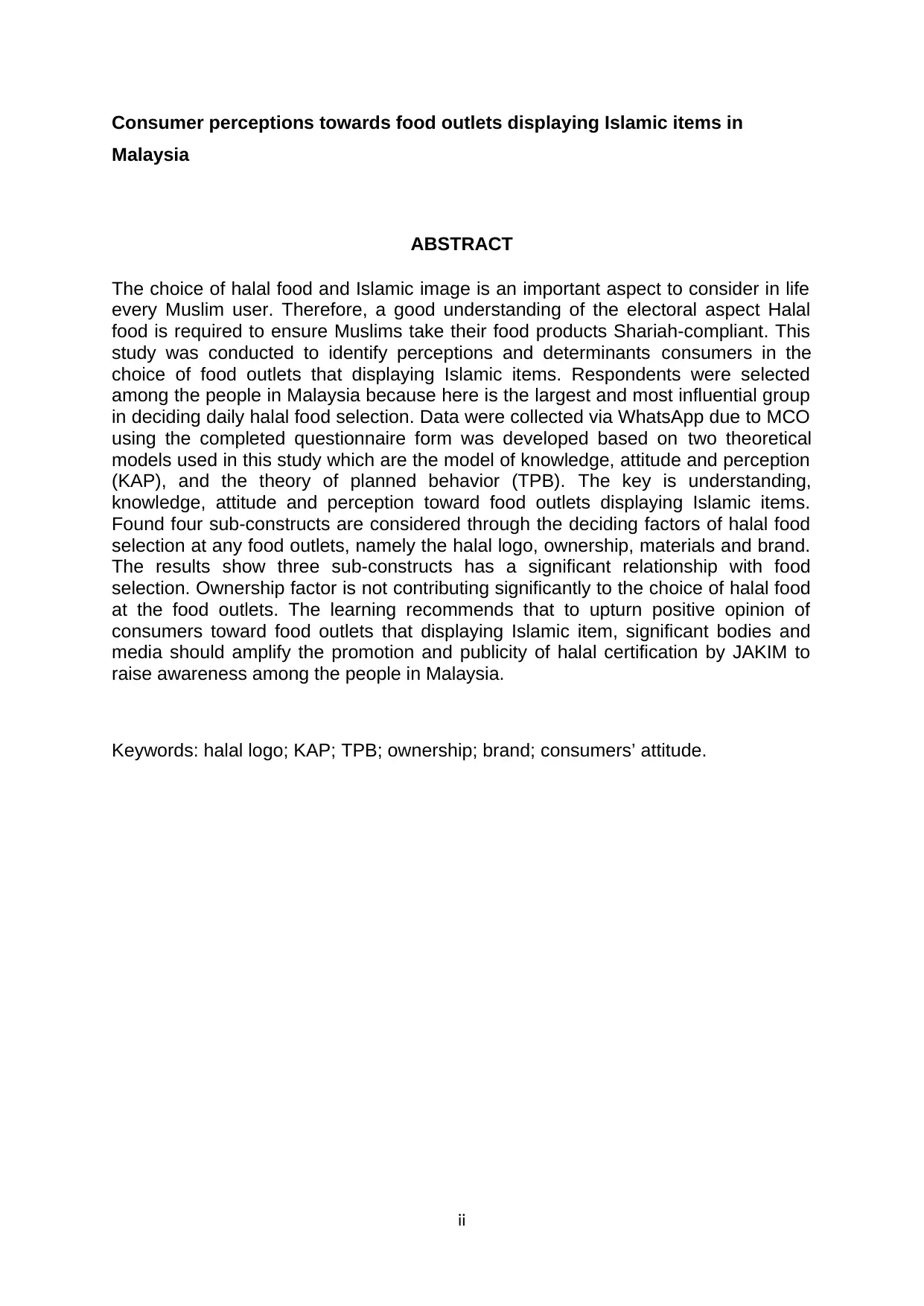
Consumer perceptions towards food outlets displaying Islamic items in
Malaysia
ABSTRACT
The choice of halal food and Islamic image is an important aspect to consider in life
every Muslim user. Therefore, a good understanding of the electoral aspect Halal
food is required to ensure Muslims take their food products Shariah-compliant. This
study was conducted to identify perceptions and determinants consumers in the
choice of food outlets that displaying Islamic items. Respondents were selected
among the people in Malaysia because here is the largest and most influential group
in deciding daily halal food selection. Data were collected via WhatsApp due to MCO
using the completed questionnaire form was developed based on two theoretical
models used in this study which are the model of knowledge, attitude and perception
(KAP), and the theory of planned behavior (TPB). The key is understanding,
knowledge, attitude and perception toward food outlets displaying Islamic items.
Found four sub-constructs are considered through the deciding factors of halal food
selection at any food outlets, namely the halal logo, ownership, materials and brand.
The results show three sub-constructs has a significant relationship with food
selection. Ownership factor is not contributing significantly to the choice of halal food
at the food outlets. The learning recommends that to upturn positive opinion of
consumers toward food outlets that displaying Islamic item, significant bodies and
media should amplify the promotion and publicity of halal certification by JAKIM to
raise awareness among the people in Malaysia.
Keywords: halal logo; KAP; TPB; ownership; brand; consumers’ attitude.
ii
Malaysia
ABSTRACT
The choice of halal food and Islamic image is an important aspect to consider in life
every Muslim user. Therefore, a good understanding of the electoral aspect Halal
food is required to ensure Muslims take their food products Shariah-compliant. This
study was conducted to identify perceptions and determinants consumers in the
choice of food outlets that displaying Islamic items. Respondents were selected
among the people in Malaysia because here is the largest and most influential group
in deciding daily halal food selection. Data were collected via WhatsApp due to MCO
using the completed questionnaire form was developed based on two theoretical
models used in this study which are the model of knowledge, attitude and perception
(KAP), and the theory of planned behavior (TPB). The key is understanding,
knowledge, attitude and perception toward food outlets displaying Islamic items.
Found four sub-constructs are considered through the deciding factors of halal food
selection at any food outlets, namely the halal logo, ownership, materials and brand.
The results show three sub-constructs has a significant relationship with food
selection. Ownership factor is not contributing significantly to the choice of halal food
at the food outlets. The learning recommends that to upturn positive opinion of
consumers toward food outlets that displaying Islamic item, significant bodies and
media should amplify the promotion and publicity of halal certification by JAKIM to
raise awareness among the people in Malaysia.
Keywords: halal logo; KAP; TPB; ownership; brand; consumers’ attitude.
ii
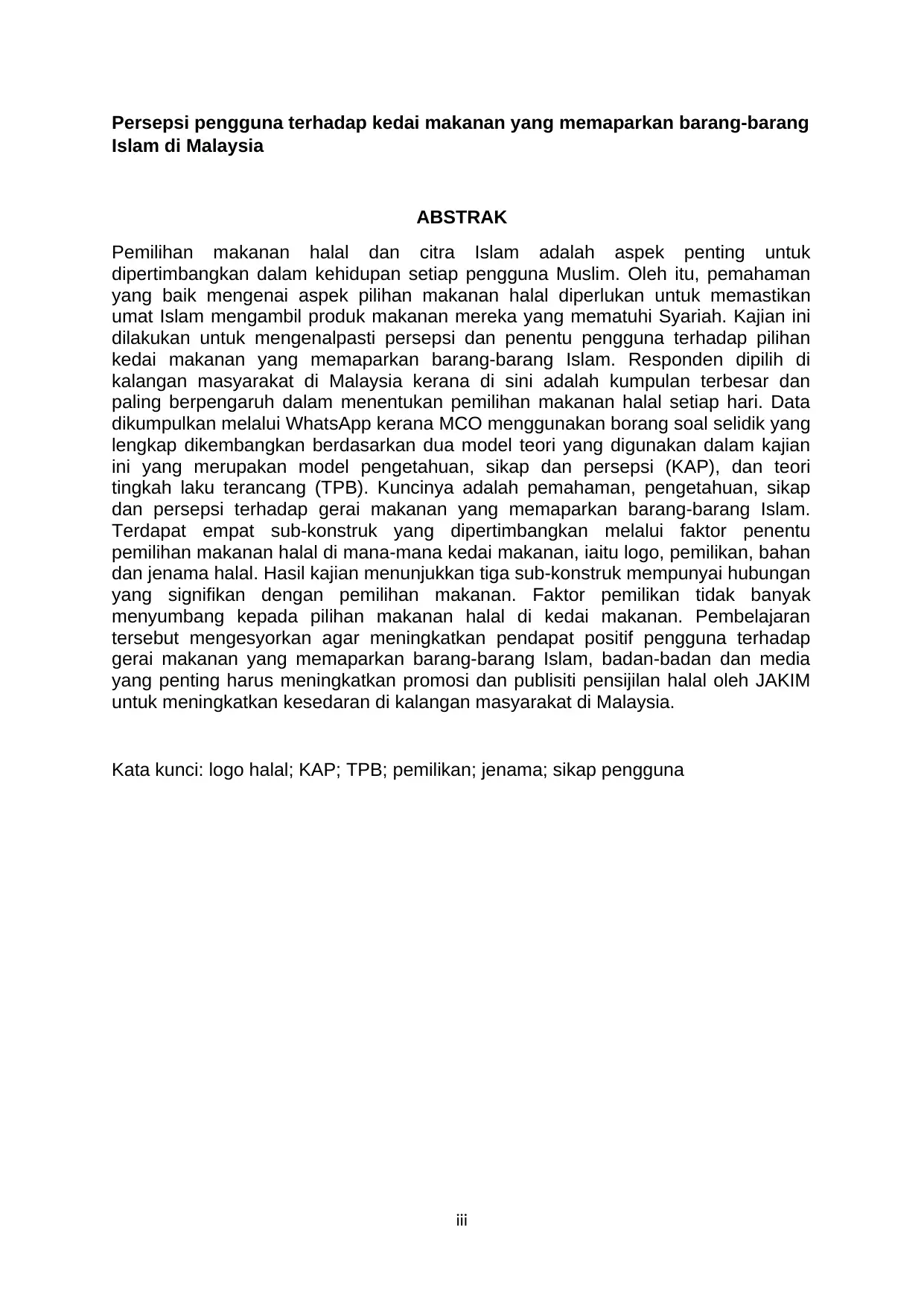
Persepsi pengguna terhadap kedai makanan yang memaparkan barang-barang
Islam di Malaysia
ABSTRAK
Pemilihan makanan halal dan citra Islam adalah aspek penting untuk
dipertimbangkan dalam kehidupan setiap pengguna Muslim. Oleh itu, pemahaman
yang baik mengenai aspek pilihan makanan halal diperlukan untuk memastikan
umat Islam mengambil produk makanan mereka yang mematuhi Syariah. Kajian ini
dilakukan untuk mengenalpasti persepsi dan penentu pengguna terhadap pilihan
kedai makanan yang memaparkan barang-barang Islam. Responden dipilih di
kalangan masyarakat di Malaysia kerana di sini adalah kumpulan terbesar dan
paling berpengaruh dalam menentukan pemilihan makanan halal setiap hari. Data
dikumpulkan melalui WhatsApp kerana MCO menggunakan borang soal selidik yang
lengkap dikembangkan berdasarkan dua model teori yang digunakan dalam kajian
ini yang merupakan model pengetahuan, sikap dan persepsi (KAP), dan teori
tingkah laku terancang (TPB). Kuncinya adalah pemahaman, pengetahuan, sikap
dan persepsi terhadap gerai makanan yang memaparkan barang-barang Islam.
Terdapat empat sub-konstruk yang dipertimbangkan melalui faktor penentu
pemilihan makanan halal di mana-mana kedai makanan, iaitu logo, pemilikan, bahan
dan jenama halal. Hasil kajian menunjukkan tiga sub-konstruk mempunyai hubungan
yang signifikan dengan pemilihan makanan. Faktor pemilikan tidak banyak
menyumbang kepada pilihan makanan halal di kedai makanan. Pembelajaran
tersebut mengesyorkan agar meningkatkan pendapat positif pengguna terhadap
gerai makanan yang memaparkan barang-barang Islam, badan-badan dan media
yang penting harus meningkatkan promosi dan publisiti pensijilan halal oleh JAKIM
untuk meningkatkan kesedaran di kalangan masyarakat di Malaysia.
Kata kunci: logo halal; KAP; TPB; pemilikan; jenama; sikap pengguna
iii
Islam di Malaysia
ABSTRAK
Pemilihan makanan halal dan citra Islam adalah aspek penting untuk
dipertimbangkan dalam kehidupan setiap pengguna Muslim. Oleh itu, pemahaman
yang baik mengenai aspek pilihan makanan halal diperlukan untuk memastikan
umat Islam mengambil produk makanan mereka yang mematuhi Syariah. Kajian ini
dilakukan untuk mengenalpasti persepsi dan penentu pengguna terhadap pilihan
kedai makanan yang memaparkan barang-barang Islam. Responden dipilih di
kalangan masyarakat di Malaysia kerana di sini adalah kumpulan terbesar dan
paling berpengaruh dalam menentukan pemilihan makanan halal setiap hari. Data
dikumpulkan melalui WhatsApp kerana MCO menggunakan borang soal selidik yang
lengkap dikembangkan berdasarkan dua model teori yang digunakan dalam kajian
ini yang merupakan model pengetahuan, sikap dan persepsi (KAP), dan teori
tingkah laku terancang (TPB). Kuncinya adalah pemahaman, pengetahuan, sikap
dan persepsi terhadap gerai makanan yang memaparkan barang-barang Islam.
Terdapat empat sub-konstruk yang dipertimbangkan melalui faktor penentu
pemilihan makanan halal di mana-mana kedai makanan, iaitu logo, pemilikan, bahan
dan jenama halal. Hasil kajian menunjukkan tiga sub-konstruk mempunyai hubungan
yang signifikan dengan pemilihan makanan. Faktor pemilikan tidak banyak
menyumbang kepada pilihan makanan halal di kedai makanan. Pembelajaran
tersebut mengesyorkan agar meningkatkan pendapat positif pengguna terhadap
gerai makanan yang memaparkan barang-barang Islam, badan-badan dan media
yang penting harus meningkatkan promosi dan publisiti pensijilan halal oleh JAKIM
untuk meningkatkan kesedaran di kalangan masyarakat di Malaysia.
Kata kunci: logo halal; KAP; TPB; pemilikan; jenama; sikap pengguna
iii
⊘ This is a preview!⊘
Do you want full access?
Subscribe today to unlock all pages.

Trusted by 1+ million students worldwide
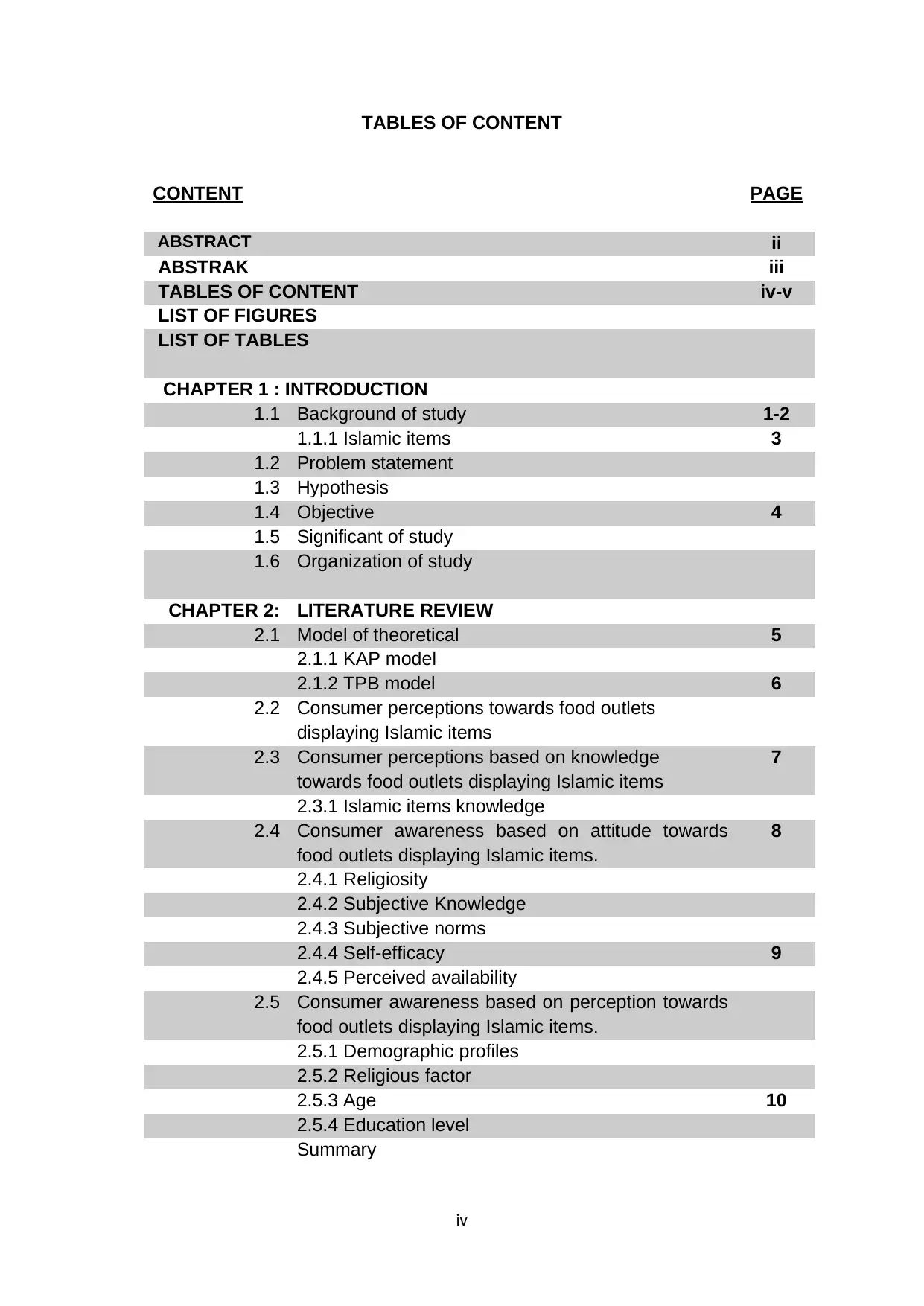
TABLES OF CONTENT
CONTENT PAGE
ABSTRACT ii
ABSTRAK iii
TABLES OF CONTENT iv-v
LIST OF FIGURES
LIST OF TABLES
CHAPTER 1 : INTRODUCTION
1.1 Background of study 1-2
1.1.1 Islamic items 3
1.2 Problem statement
1.3 Hypothesis
1.4 Objective 4
1.5 Significant of study
1.6 Organization of study
CHAPTER 2: LITERATURE REVIEW
2.1 Model of theoretical 5
2.1.1 KAP model
2.1.2 TPB model 6
2.2 Consumer perceptions towards food outlets
displaying Islamic items
2.3 Consumer perceptions based on knowledge
towards food outlets displaying Islamic items
7
2.3.1 Islamic items knowledge
2.4 Consumer awareness based on attitude towards
food outlets displaying Islamic items.
8
2.4.1 Religiosity
2.4.2 Subjective Knowledge
2.4.3 Subjective norms
2.4.4 Self-efficacy 9
2.4.5 Perceived availability
2.5 Consumer awareness based on perception towards
food outlets displaying Islamic items.
2.5.1 Demographic profiles
2.5.2 Religious factor
2.5.3 Age 10
2.5.4 Education level
Summary
iv
CONTENT PAGE
ABSTRACT ii
ABSTRAK iii
TABLES OF CONTENT iv-v
LIST OF FIGURES
LIST OF TABLES
CHAPTER 1 : INTRODUCTION
1.1 Background of study 1-2
1.1.1 Islamic items 3
1.2 Problem statement
1.3 Hypothesis
1.4 Objective 4
1.5 Significant of study
1.6 Organization of study
CHAPTER 2: LITERATURE REVIEW
2.1 Model of theoretical 5
2.1.1 KAP model
2.1.2 TPB model 6
2.2 Consumer perceptions towards food outlets
displaying Islamic items
2.3 Consumer perceptions based on knowledge
towards food outlets displaying Islamic items
7
2.3.1 Islamic items knowledge
2.4 Consumer awareness based on attitude towards
food outlets displaying Islamic items.
8
2.4.1 Religiosity
2.4.2 Subjective Knowledge
2.4.3 Subjective norms
2.4.4 Self-efficacy 9
2.4.5 Perceived availability
2.5 Consumer awareness based on perception towards
food outlets displaying Islamic items.
2.5.1 Demographic profiles
2.5.2 Religious factor
2.5.3 Age 10
2.5.4 Education level
Summary
iv
Paraphrase This Document
Need a fresh take? Get an instant paraphrase of this document with our AI Paraphraser
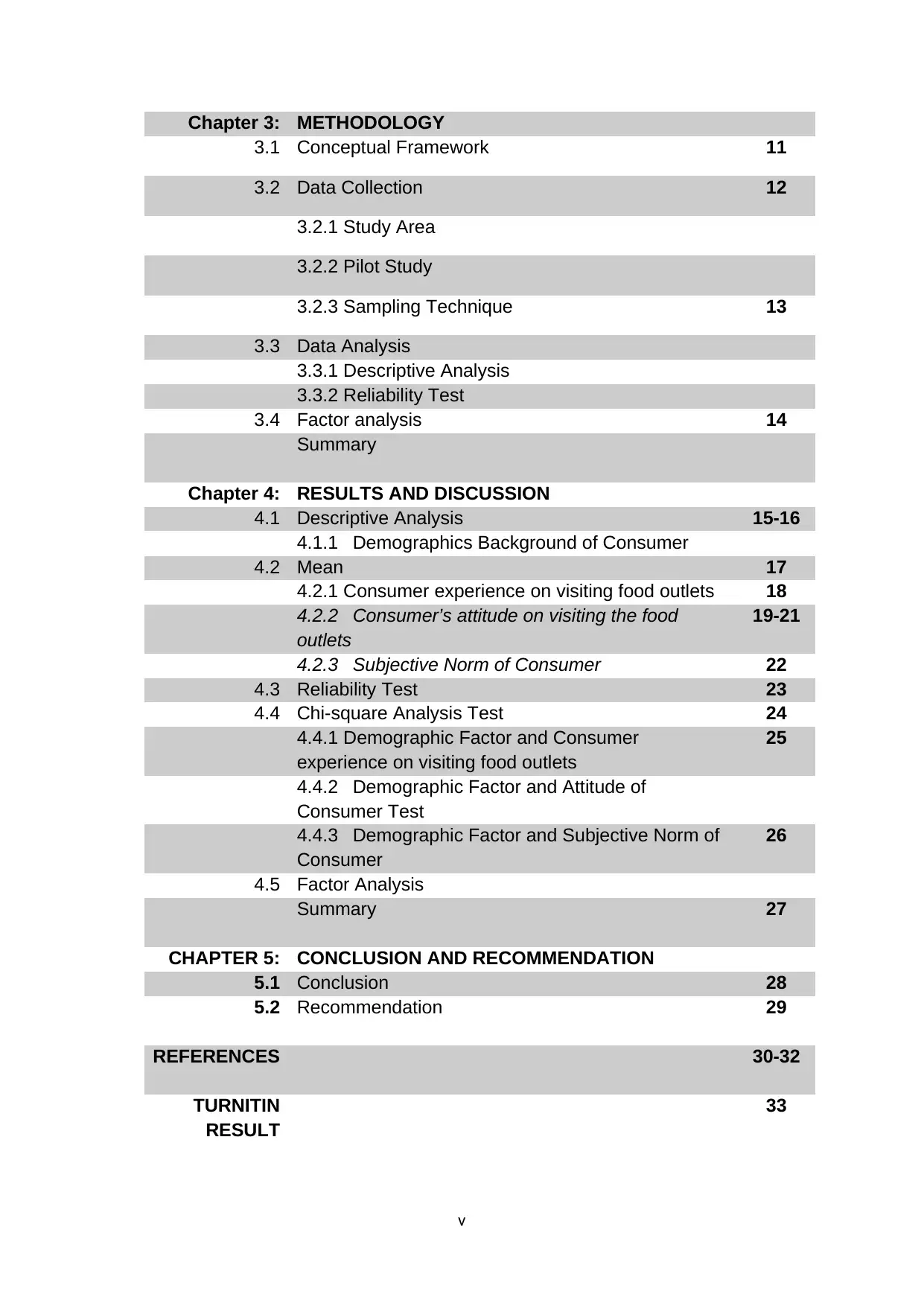
Chapter 3: METHODOLOGY
3.1 Conceptual Framework 11
3.2 Data Collection 12
3.2.1 Study Area
3.2.2 Pilot Study
3.2.3 Sampling Technique 13
3.3 Data Analysis
3.3.1 Descriptive Analysis
3.3.2 Reliability Test
3.4 Factor analysis 14
Summary
Chapter 4: RESULTS AND DISCUSSION
4.1 Descriptive Analysis 15-16
4.1.1 Demographics Background of Consumer
4.2 Mean 17
4.2.1 Consumer experience on visiting food outlets 18
4.2.2 Consumer’s attitude on visiting the food
outlets
19-21
4.2.3 Subjective Norm of Consumer 22
4.3 Reliability Test 23
4.4 Chi-square Analysis Test 24
4.4.1 Demographic Factor and Consumer
experience on visiting food outlets
25
4.4.2 Demographic Factor and Attitude of
Consumer Test
4.4.3 Demographic Factor and Subjective Norm of
Consumer
26
4.5 Factor Analysis
Summary 27
CHAPTER 5: CONCLUSION AND RECOMMENDATION
5.1 Conclusion 28
5.2 Recommendation 29
REFERENCES 30-32
TURNITIN
RESULT
33
v
3.1 Conceptual Framework 11
3.2 Data Collection 12
3.2.1 Study Area
3.2.2 Pilot Study
3.2.3 Sampling Technique 13
3.3 Data Analysis
3.3.1 Descriptive Analysis
3.3.2 Reliability Test
3.4 Factor analysis 14
Summary
Chapter 4: RESULTS AND DISCUSSION
4.1 Descriptive Analysis 15-16
4.1.1 Demographics Background of Consumer
4.2 Mean 17
4.2.1 Consumer experience on visiting food outlets 18
4.2.2 Consumer’s attitude on visiting the food
outlets
19-21
4.2.3 Subjective Norm of Consumer 22
4.3 Reliability Test 23
4.4 Chi-square Analysis Test 24
4.4.1 Demographic Factor and Consumer
experience on visiting food outlets
25
4.4.2 Demographic Factor and Attitude of
Consumer Test
4.4.3 Demographic Factor and Subjective Norm of
Consumer
26
4.5 Factor Analysis
Summary 27
CHAPTER 5: CONCLUSION AND RECOMMENDATION
5.1 Conclusion 28
5.2 Recommendation 29
REFERENCES 30-32
TURNITIN
RESULT
33
v
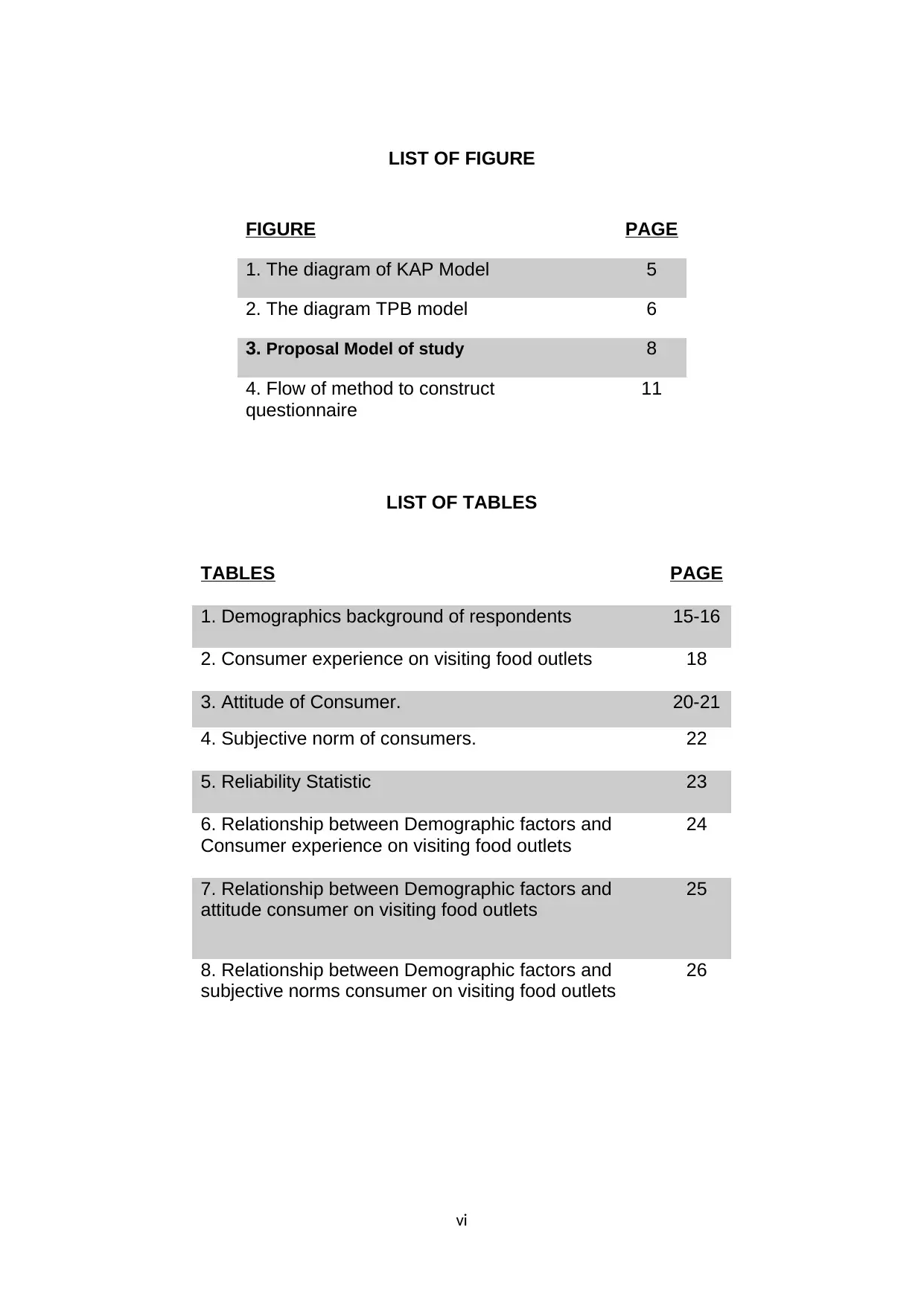
LIST OF FIGURE
FIGURE PAGE
1. The diagram of KAP Model 5
2. The diagram TPB model 6
3. Proposal Model of study 8
4. Flow of method to construct
questionnaire
11
LIST OF TABLES
TABLES PAGE
1. Demographics background of respondents 15-16
2. Consumer experience on visiting food outlets 18
3. Attitude of Consumer. 20-21
4. Subjective norm of consumers. 22
5. Reliability Statistic 23
6. Relationship between Demographic factors and
Consumer experience on visiting food outlets
24
7. Relationship between Demographic factors and
attitude consumer on visiting food outlets
25
8. Relationship between Demographic factors and
subjective norms consumer on visiting food outlets
26
vi
FIGURE PAGE
1. The diagram of KAP Model 5
2. The diagram TPB model 6
3. Proposal Model of study 8
4. Flow of method to construct
questionnaire
11
LIST OF TABLES
TABLES PAGE
1. Demographics background of respondents 15-16
2. Consumer experience on visiting food outlets 18
3. Attitude of Consumer. 20-21
4. Subjective norm of consumers. 22
5. Reliability Statistic 23
6. Relationship between Demographic factors and
Consumer experience on visiting food outlets
24
7. Relationship between Demographic factors and
attitude consumer on visiting food outlets
25
8. Relationship between Demographic factors and
subjective norms consumer on visiting food outlets
26
vi
⊘ This is a preview!⊘
Do you want full access?
Subscribe today to unlock all pages.

Trusted by 1+ million students worldwide
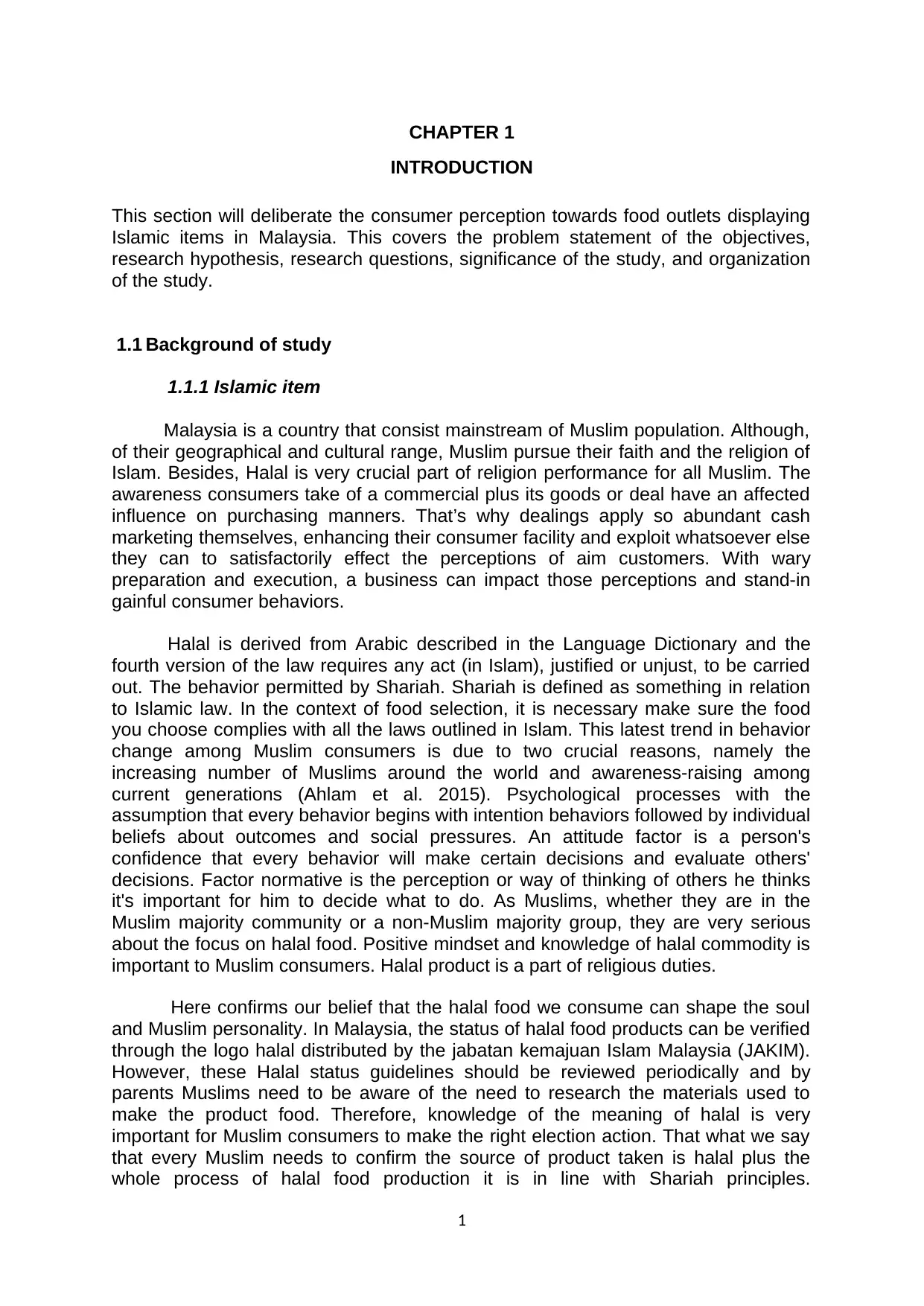
CHAPTER 1
INTRODUCTION
This section will deliberate the consumer perception towards food outlets displaying
Islamic items in Malaysia. This covers the problem statement of the objectives,
research hypothesis, research questions, significance of the study, and organization
of the study.
1.1 Background of study
1.1.1 Islamic item
Malaysia is a country that consist mainstream of Muslim population. Although,
of their geographical and cultural range, Muslim pursue their faith and the religion of
Islam. Besides, Halal is very crucial part of religion performance for all Muslim. The
awareness consumers take of a commercial plus its goods or deal have an affected
influence on purchasing manners. That’s why dealings apply so abundant cash
marketing themselves, enhancing their consumer facility and exploit whatsoever else
they can to satisfactorily effect the perceptions of aim customers. With wary
preparation and execution, a business can impact those perceptions and stand-in
gainful consumer behaviors.
Halal is derived from Arabic described in the Language Dictionary and the
fourth version of the law requires any act (in Islam), justified or unjust, to be carried
out. The behavior permitted by Shariah. Shariah is defined as something in relation
to Islamic law. In the context of food selection, it is necessary make sure the food
you choose complies with all the laws outlined in Islam. This latest trend in behavior
change among Muslim consumers is due to two crucial reasons, namely the
increasing number of Muslims around the world and awareness-raising among
current generations (Ahlam et al. 2015). Psychological processes with the
assumption that every behavior begins with intention behaviors followed by individual
beliefs about outcomes and social pressures. An attitude factor is a person's
confidence that every behavior will make certain decisions and evaluate others'
decisions. Factor normative is the perception or way of thinking of others he thinks
it's important for him to decide what to do. As Muslims, whether they are in the
Muslim majority community or a non-Muslim majority group, they are very serious
about the focus on halal food. Positive mindset and knowledge of halal commodity is
important to Muslim consumers. Halal product is a part of religious duties.
Here confirms our belief that the halal food we consume can shape the soul
and Muslim personality. In Malaysia, the status of halal food products can be verified
through the logo halal distributed by the jabatan kemajuan Islam Malaysia (JAKIM).
However, these Halal status guidelines should be reviewed periodically and by
parents Muslims need to be aware of the need to research the materials used to
make the product food. Therefore, knowledge of the meaning of halal is very
important for Muslim consumers to make the right election action. That what we say
that every Muslim needs to confirm the source of product taken is halal plus the
whole process of halal food production it is in line with Shariah principles.
1
INTRODUCTION
This section will deliberate the consumer perception towards food outlets displaying
Islamic items in Malaysia. This covers the problem statement of the objectives,
research hypothesis, research questions, significance of the study, and organization
of the study.
1.1 Background of study
1.1.1 Islamic item
Malaysia is a country that consist mainstream of Muslim population. Although,
of their geographical and cultural range, Muslim pursue their faith and the religion of
Islam. Besides, Halal is very crucial part of religion performance for all Muslim. The
awareness consumers take of a commercial plus its goods or deal have an affected
influence on purchasing manners. That’s why dealings apply so abundant cash
marketing themselves, enhancing their consumer facility and exploit whatsoever else
they can to satisfactorily effect the perceptions of aim customers. With wary
preparation and execution, a business can impact those perceptions and stand-in
gainful consumer behaviors.
Halal is derived from Arabic described in the Language Dictionary and the
fourth version of the law requires any act (in Islam), justified or unjust, to be carried
out. The behavior permitted by Shariah. Shariah is defined as something in relation
to Islamic law. In the context of food selection, it is necessary make sure the food
you choose complies with all the laws outlined in Islam. This latest trend in behavior
change among Muslim consumers is due to two crucial reasons, namely the
increasing number of Muslims around the world and awareness-raising among
current generations (Ahlam et al. 2015). Psychological processes with the
assumption that every behavior begins with intention behaviors followed by individual
beliefs about outcomes and social pressures. An attitude factor is a person's
confidence that every behavior will make certain decisions and evaluate others'
decisions. Factor normative is the perception or way of thinking of others he thinks
it's important for him to decide what to do. As Muslims, whether they are in the
Muslim majority community or a non-Muslim majority group, they are very serious
about the focus on halal food. Positive mindset and knowledge of halal commodity is
important to Muslim consumers. Halal product is a part of religious duties.
Here confirms our belief that the halal food we consume can shape the soul
and Muslim personality. In Malaysia, the status of halal food products can be verified
through the logo halal distributed by the jabatan kemajuan Islam Malaysia (JAKIM).
However, these Halal status guidelines should be reviewed periodically and by
parents Muslims need to be aware of the need to research the materials used to
make the product food. Therefore, knowledge of the meaning of halal is very
important for Muslim consumers to make the right election action. That what we say
that every Muslim needs to confirm the source of product taken is halal plus the
whole process of halal food production it is in line with Shariah principles.
1
Paraphrase This Document
Need a fresh take? Get an instant paraphrase of this document with our AI Paraphraser
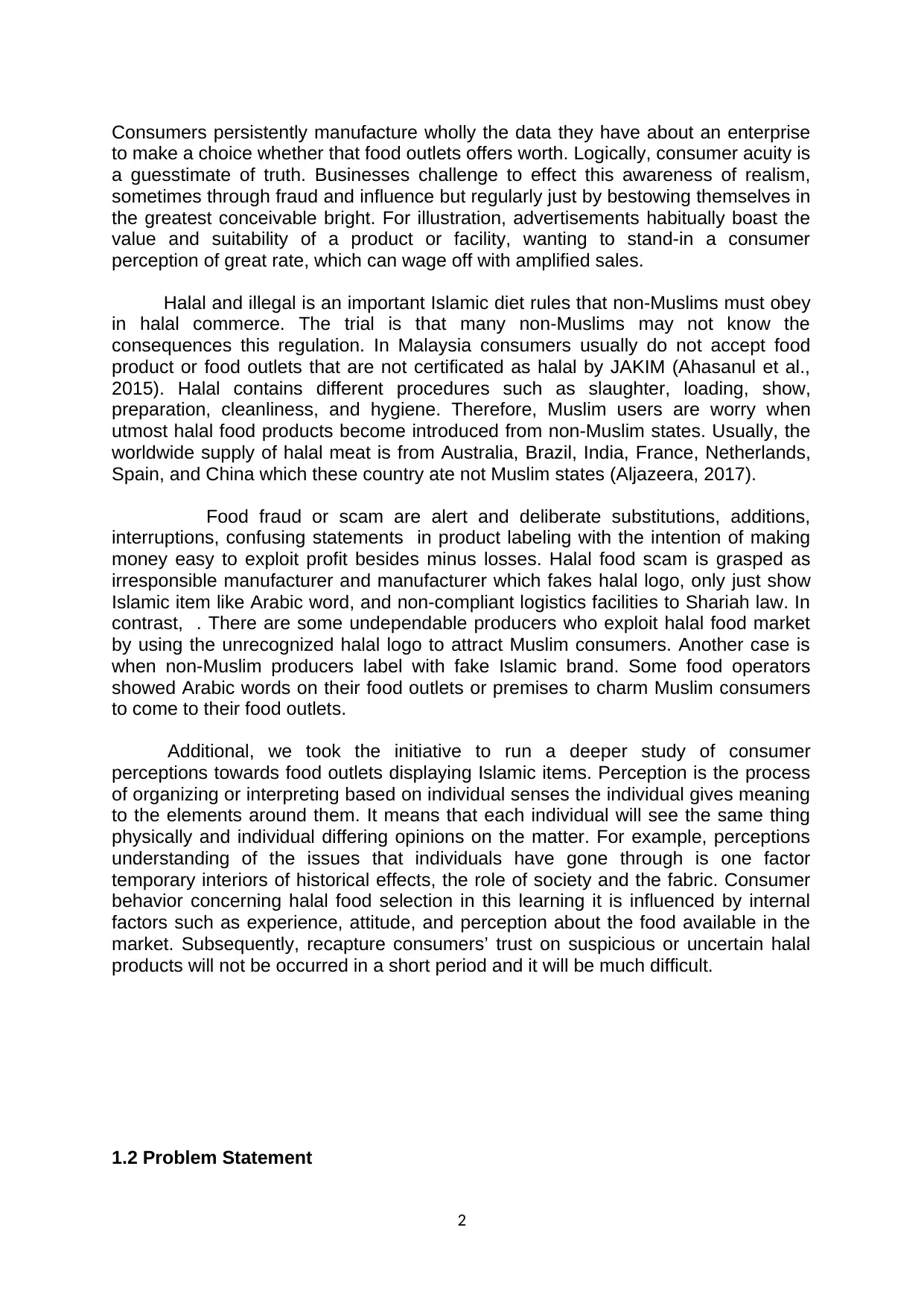
Consumers persistently manufacture wholly the data they have about an enterprise
to make a choice whether that food outlets offers worth. Logically, consumer acuity is
a guesstimate of truth. Businesses challenge to effect this awareness of realism,
sometimes through fraud and influence but regularly just by bestowing themselves in
the greatest conceivable bright. For illustration, advertisements habitually boast the
value and suitability of a product or facility, wanting to stand-in a consumer
perception of great rate, which can wage off with amplified sales.
Halal and illegal is an important Islamic diet rules that non-Muslims must obey
in halal commerce. The trial is that many non-Muslims may not know the
consequences this regulation. In Malaysia consumers usually do not accept food
product or food outlets that are not certificated as halal by JAKIM (Ahasanul et al.,
2015). Halal contains different procedures such as slaughter, loading, show,
preparation, cleanliness, and hygiene. Therefore, Muslim users are worry when
utmost halal food products become introduced from non-Muslim states. Usually, the
worldwide supply of halal meat is from Australia, Brazil, India, France, Netherlands,
Spain, and China which these country ate not Muslim states (Aljazeera, 2017).
Food fraud or scam are alert and deliberate substitutions, additions,
interruptions, confusing statements in product labeling with the intention of making
money easy to exploit profit besides minus losses. Halal food scam is grasped as
irresponsible manufacturer and manufacturer which fakes halal logo, only just show
Islamic item like Arabic word, and non-compliant logistics facilities to Shariah law. In
contrast, . There are some undependable producers who exploit halal food market
by using the unrecognized halal logo to attract Muslim consumers. Another case is
when non-Muslim producers label with fake Islamic brand. Some food operators
showed Arabic words on their food outlets or premises to charm Muslim consumers
to come to their food outlets.
Additional, we took the initiative to run a deeper study of consumer
perceptions towards food outlets displaying Islamic items. Perception is the process
of organizing or interpreting based on individual senses the individual gives meaning
to the elements around them. It means that each individual will see the same thing
physically and individual differing opinions on the matter. For example, perceptions
understanding of the issues that individuals have gone through is one factor
temporary interiors of historical effects, the role of society and the fabric. Consumer
behavior concerning halal food selection in this learning it is influenced by internal
factors such as experience, attitude, and perception about the food available in the
market. Subsequently, recapture consumers’ trust on suspicious or uncertain halal
products will not be occurred in a short period and it will be much difficult.
1.2 Problem Statement
2
to make a choice whether that food outlets offers worth. Logically, consumer acuity is
a guesstimate of truth. Businesses challenge to effect this awareness of realism,
sometimes through fraud and influence but regularly just by bestowing themselves in
the greatest conceivable bright. For illustration, advertisements habitually boast the
value and suitability of a product or facility, wanting to stand-in a consumer
perception of great rate, which can wage off with amplified sales.
Halal and illegal is an important Islamic diet rules that non-Muslims must obey
in halal commerce. The trial is that many non-Muslims may not know the
consequences this regulation. In Malaysia consumers usually do not accept food
product or food outlets that are not certificated as halal by JAKIM (Ahasanul et al.,
2015). Halal contains different procedures such as slaughter, loading, show,
preparation, cleanliness, and hygiene. Therefore, Muslim users are worry when
utmost halal food products become introduced from non-Muslim states. Usually, the
worldwide supply of halal meat is from Australia, Brazil, India, France, Netherlands,
Spain, and China which these country ate not Muslim states (Aljazeera, 2017).
Food fraud or scam are alert and deliberate substitutions, additions,
interruptions, confusing statements in product labeling with the intention of making
money easy to exploit profit besides minus losses. Halal food scam is grasped as
irresponsible manufacturer and manufacturer which fakes halal logo, only just show
Islamic item like Arabic word, and non-compliant logistics facilities to Shariah law. In
contrast, . There are some undependable producers who exploit halal food market
by using the unrecognized halal logo to attract Muslim consumers. Another case is
when non-Muslim producers label with fake Islamic brand. Some food operators
showed Arabic words on their food outlets or premises to charm Muslim consumers
to come to their food outlets.
Additional, we took the initiative to run a deeper study of consumer
perceptions towards food outlets displaying Islamic items. Perception is the process
of organizing or interpreting based on individual senses the individual gives meaning
to the elements around them. It means that each individual will see the same thing
physically and individual differing opinions on the matter. For example, perceptions
understanding of the issues that individuals have gone through is one factor
temporary interiors of historical effects, the role of society and the fabric. Consumer
behavior concerning halal food selection in this learning it is influenced by internal
factors such as experience, attitude, and perception about the food available in the
market. Subsequently, recapture consumers’ trust on suspicious or uncertain halal
products will not be occurred in a short period and it will be much difficult.
1.2 Problem Statement
2
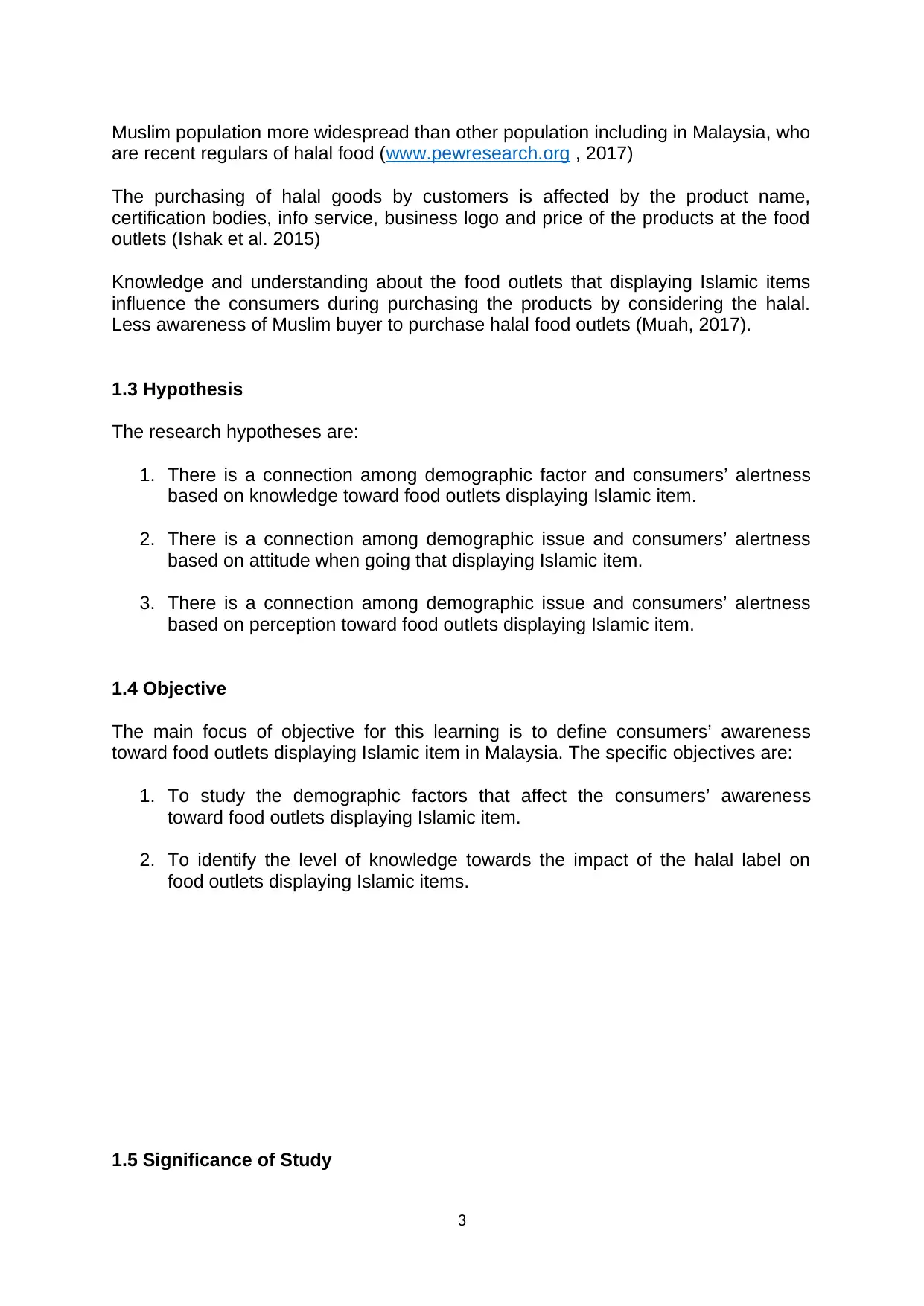
Muslim population more widespread than other population including in Malaysia, who
are recent regulars of halal food (www.pewresearch.org , 2017)
The purchasing of halal goods by customers is affected by the product name,
certification bodies, info service, business logo and price of the products at the food
outlets (Ishak et al. 2015)
Knowledge and understanding about the food outlets that displaying Islamic items
influence the consumers during purchasing the products by considering the halal.
Less awareness of Muslim buyer to purchase halal food outlets (Muah, 2017).
1.3 Hypothesis
The research hypotheses are:
1. There is a connection among demographic factor and consumers’ alertness
based on knowledge toward food outlets displaying Islamic item.
2. There is a connection among demographic issue and consumers’ alertness
based on attitude when going that displaying Islamic item.
3. There is a connection among demographic issue and consumers’ alertness
based on perception toward food outlets displaying Islamic item.
1.4 Objective
The main focus of objective for this learning is to define consumers’ awareness
toward food outlets displaying Islamic item in Malaysia. The specific objectives are:
1. To study the demographic factors that affect the consumers’ awareness
toward food outlets displaying Islamic item.
2. To identify the level of knowledge towards the impact of the halal label on
food outlets displaying Islamic items.
1.5 Significance of Study
3
are recent regulars of halal food (www.pewresearch.org , 2017)
The purchasing of halal goods by customers is affected by the product name,
certification bodies, info service, business logo and price of the products at the food
outlets (Ishak et al. 2015)
Knowledge and understanding about the food outlets that displaying Islamic items
influence the consumers during purchasing the products by considering the halal.
Less awareness of Muslim buyer to purchase halal food outlets (Muah, 2017).
1.3 Hypothesis
The research hypotheses are:
1. There is a connection among demographic factor and consumers’ alertness
based on knowledge toward food outlets displaying Islamic item.
2. There is a connection among demographic issue and consumers’ alertness
based on attitude when going that displaying Islamic item.
3. There is a connection among demographic issue and consumers’ alertness
based on perception toward food outlets displaying Islamic item.
1.4 Objective
The main focus of objective for this learning is to define consumers’ awareness
toward food outlets displaying Islamic item in Malaysia. The specific objectives are:
1. To study the demographic factors that affect the consumers’ awareness
toward food outlets displaying Islamic item.
2. To identify the level of knowledge towards the impact of the halal label on
food outlets displaying Islamic items.
1.5 Significance of Study
3
⊘ This is a preview!⊘
Do you want full access?
Subscribe today to unlock all pages.

Trusted by 1+ million students worldwide
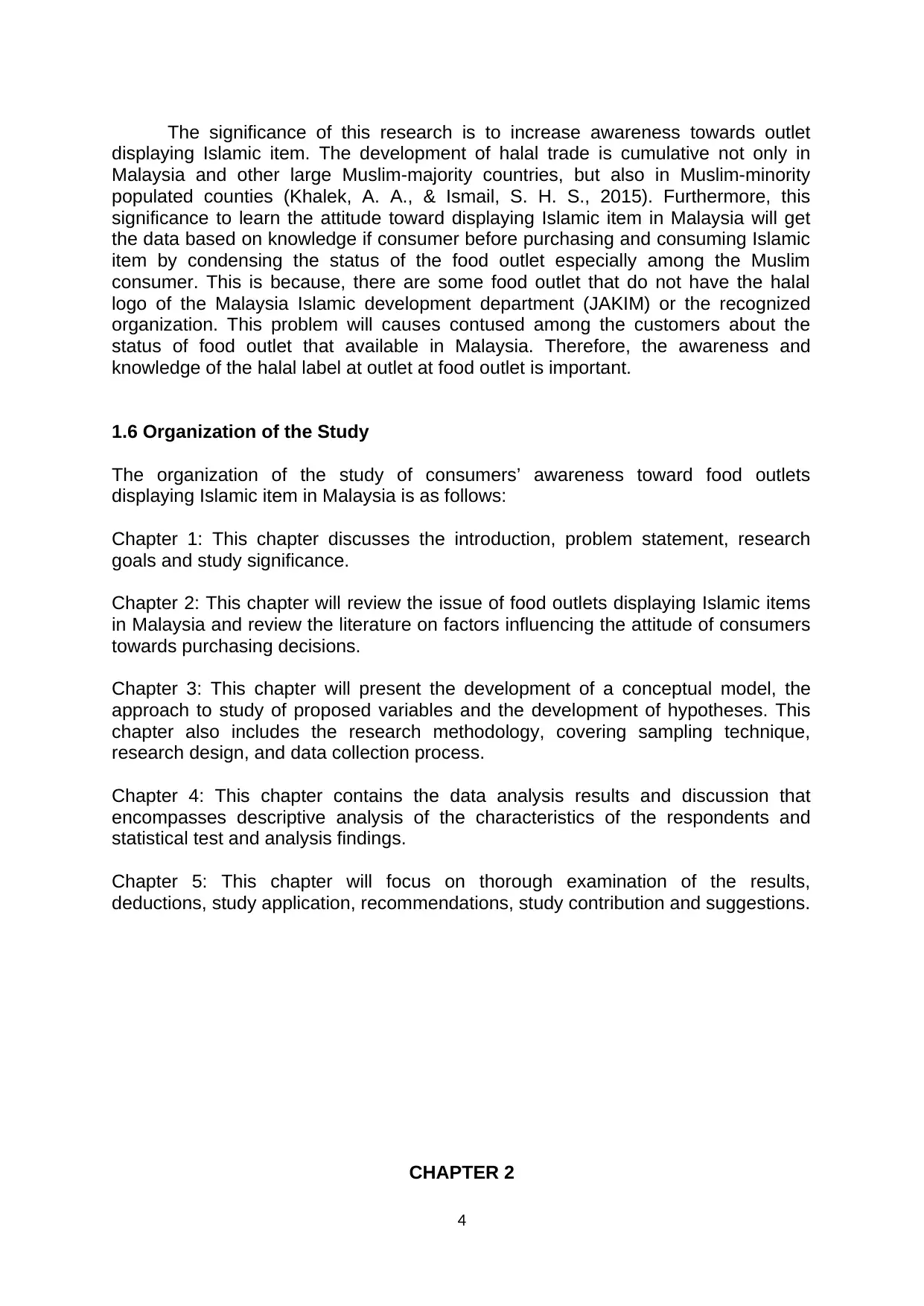
The significance of this research is to increase awareness towards outlet
displaying Islamic item. The development of halal trade is cumulative not only in
Malaysia and other large Muslim-majority countries, but also in Muslim-minority
populated counties (Khalek, A. A., & Ismail, S. H. S., 2015). Furthermore, this
significance to learn the attitude toward displaying Islamic item in Malaysia will get
the data based on knowledge if consumer before purchasing and consuming Islamic
item by condensing the status of the food outlet especially among the Muslim
consumer. This is because, there are some food outlet that do not have the halal
logo of the Malaysia Islamic development department (JAKIM) or the recognized
organization. This problem will causes contused among the customers about the
status of food outlet that available in Malaysia. Therefore, the awareness and
knowledge of the halal label at outlet at food outlet is important.
1.6 Organization of the Study
The organization of the study of consumers’ awareness toward food outlets
displaying Islamic item in Malaysia is as follows:
Chapter 1: This chapter discusses the introduction, problem statement, research
goals and study significance.
Chapter 2: This chapter will review the issue of food outlets displaying Islamic items
in Malaysia and review the literature on factors influencing the attitude of consumers
towards purchasing decisions.
Chapter 3: This chapter will present the development of a conceptual model, the
approach to study of proposed variables and the development of hypotheses. This
chapter also includes the research methodology, covering sampling technique,
research design, and data collection process.
Chapter 4: This chapter contains the data analysis results and discussion that
encompasses descriptive analysis of the characteristics of the respondents and
statistical test and analysis findings.
Chapter 5: This chapter will focus on thorough examination of the results,
deductions, study application, recommendations, study contribution and suggestions.
CHAPTER 2
4
displaying Islamic item. The development of halal trade is cumulative not only in
Malaysia and other large Muslim-majority countries, but also in Muslim-minority
populated counties (Khalek, A. A., & Ismail, S. H. S., 2015). Furthermore, this
significance to learn the attitude toward displaying Islamic item in Malaysia will get
the data based on knowledge if consumer before purchasing and consuming Islamic
item by condensing the status of the food outlet especially among the Muslim
consumer. This is because, there are some food outlet that do not have the halal
logo of the Malaysia Islamic development department (JAKIM) or the recognized
organization. This problem will causes contused among the customers about the
status of food outlet that available in Malaysia. Therefore, the awareness and
knowledge of the halal label at outlet at food outlet is important.
1.6 Organization of the Study
The organization of the study of consumers’ awareness toward food outlets
displaying Islamic item in Malaysia is as follows:
Chapter 1: This chapter discusses the introduction, problem statement, research
goals and study significance.
Chapter 2: This chapter will review the issue of food outlets displaying Islamic items
in Malaysia and review the literature on factors influencing the attitude of consumers
towards purchasing decisions.
Chapter 3: This chapter will present the development of a conceptual model, the
approach to study of proposed variables and the development of hypotheses. This
chapter also includes the research methodology, covering sampling technique,
research design, and data collection process.
Chapter 4: This chapter contains the data analysis results and discussion that
encompasses descriptive analysis of the characteristics of the respondents and
statistical test and analysis findings.
Chapter 5: This chapter will focus on thorough examination of the results,
deductions, study application, recommendations, study contribution and suggestions.
CHAPTER 2
4
Paraphrase This Document
Need a fresh take? Get an instant paraphrase of this document with our AI Paraphraser
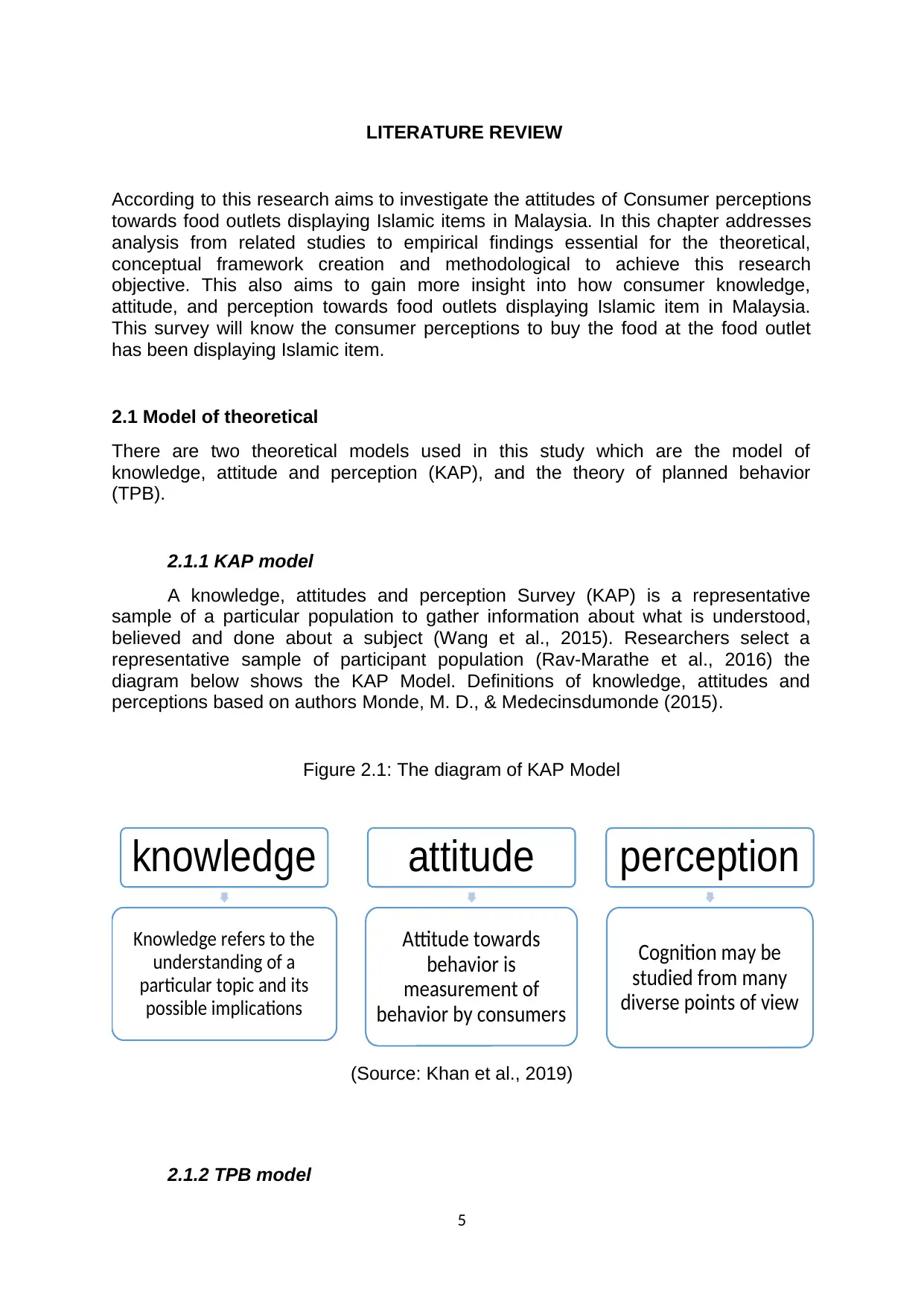
LITERATURE REVIEW
According to this research aims to investigate the attitudes of Consumer perceptions
towards food outlets displaying Islamic items in Malaysia. In this chapter addresses
analysis from related studies to empirical findings essential for the theoretical,
conceptual framework creation and methodological to achieve this research
objective. This also aims to gain more insight into how consumer knowledge,
attitude, and perception towards food outlets displaying Islamic item in Malaysia.
This survey will know the consumer perceptions to buy the food at the food outlet
has been displaying Islamic item.
2.1 Model of theoretical
There are two theoretical models used in this study which are the model of
knowledge, attitude and perception (KAP), and the theory of planned behavior
(TPB).
2.1.1 KAP model
A knowledge, attitudes and perception Survey (KAP) is a representative
sample of a particular population to gather information about what is understood,
believed and done about a subject (Wang et al., 2015). Researchers select a
representative sample of participant population (Rav-Marathe et al., 2016) the
diagram below shows the KAP Model. Definitions of knowledge, attitudes and
perceptions based on authors Monde, M. D., & Medecinsdumonde (2015).
Figure 2.1: The diagram of KAP Model
(Source: Khan et al., 2019)
2.1.2 TPB model
5
knowledge
Knowledge refers to the
understanding of a
particular topic and its
possible implications
attitude
Attitude towards
behavior is
measurement of
behavior by consumers
perception
Cognition may be
studied from many
diverse points of view
According to this research aims to investigate the attitudes of Consumer perceptions
towards food outlets displaying Islamic items in Malaysia. In this chapter addresses
analysis from related studies to empirical findings essential for the theoretical,
conceptual framework creation and methodological to achieve this research
objective. This also aims to gain more insight into how consumer knowledge,
attitude, and perception towards food outlets displaying Islamic item in Malaysia.
This survey will know the consumer perceptions to buy the food at the food outlet
has been displaying Islamic item.
2.1 Model of theoretical
There are two theoretical models used in this study which are the model of
knowledge, attitude and perception (KAP), and the theory of planned behavior
(TPB).
2.1.1 KAP model
A knowledge, attitudes and perception Survey (KAP) is a representative
sample of a particular population to gather information about what is understood,
believed and done about a subject (Wang et al., 2015). Researchers select a
representative sample of participant population (Rav-Marathe et al., 2016) the
diagram below shows the KAP Model. Definitions of knowledge, attitudes and
perceptions based on authors Monde, M. D., & Medecinsdumonde (2015).
Figure 2.1: The diagram of KAP Model
(Source: Khan et al., 2019)
2.1.2 TPB model
5
knowledge
Knowledge refers to the
understanding of a
particular topic and its
possible implications
attitude
Attitude towards
behavior is
measurement of
behavior by consumers
perception
Cognition may be
studied from many
diverse points of view
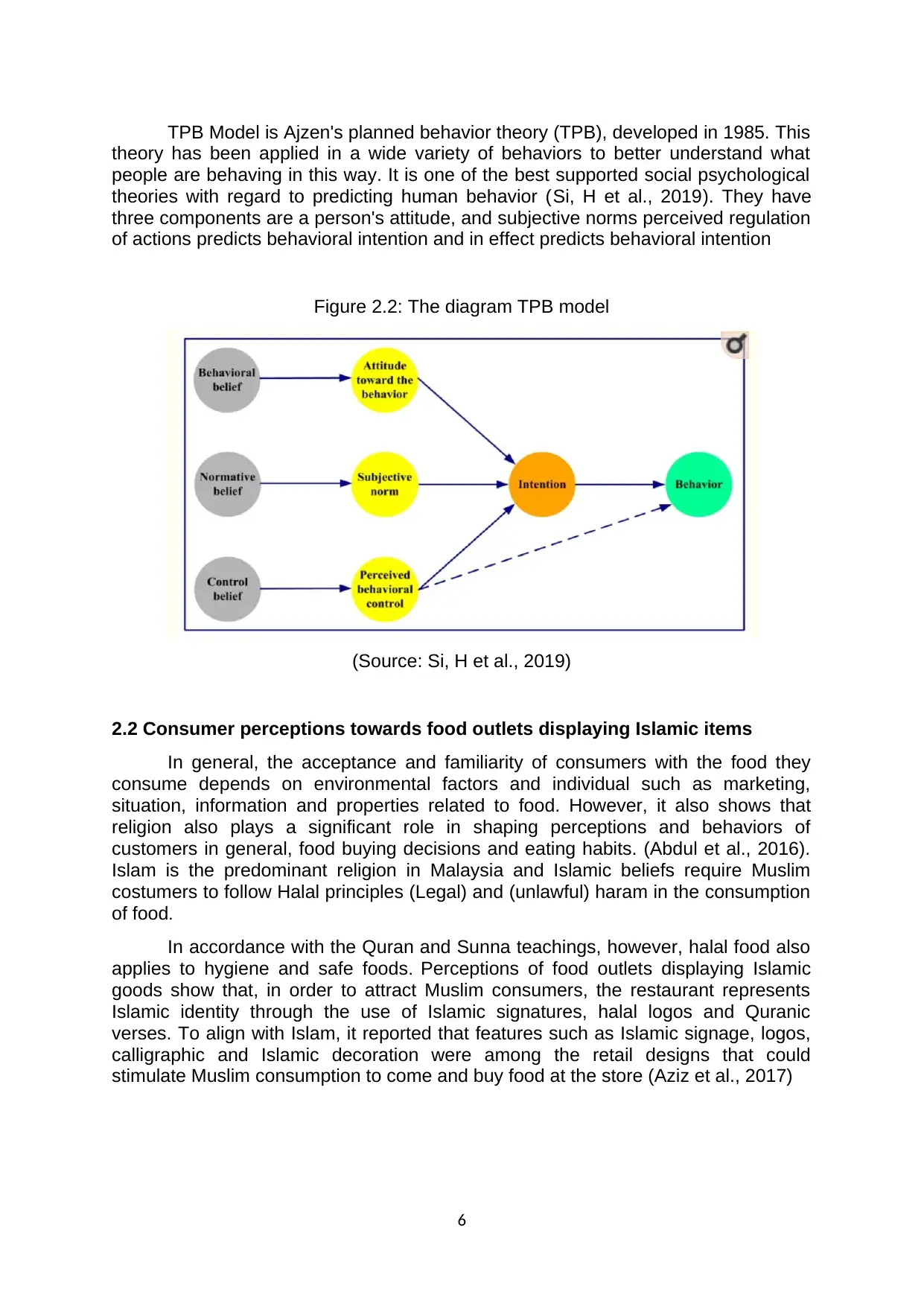
TPB Model is Ajzen's planned behavior theory (TPB), developed in 1985. This
theory has been applied in a wide variety of behaviors to better understand what
people are behaving in this way. It is one of the best supported social psychological
theories with regard to predicting human behavior (Si, H et al., 2019). They have
three components are a person's attitude, and subjective norms perceived regulation
of actions predicts behavioral intention and in effect predicts behavioral intention
Figure 2.2: The diagram TPB model
(Source: Si, H et al., 2019)
2.2 Consumer perceptions towards food outlets displaying Islamic items
In general, the acceptance and familiarity of consumers with the food they
consume depends on environmental factors and individual such as marketing,
situation, information and properties related to food. However, it also shows that
religion also plays a significant role in shaping perceptions and behaviors of
customers in general, food buying decisions and eating habits. (Abdul et al., 2016).
Islam is the predominant religion in Malaysia and Islamic beliefs require Muslim
costumers to follow Halal principles (Legal) and (unlawful) haram in the consumption
of food.
In accordance with the Quran and Sunna teachings, however, halal food also
applies to hygiene and safe foods. Perceptions of food outlets displaying Islamic
goods show that, in order to attract Muslim consumers, the restaurant represents
Islamic identity through the use of Islamic signatures, halal logos and Quranic
verses. To align with Islam, it reported that features such as Islamic signage, logos,
calligraphic and Islamic decoration were among the retail designs that could
stimulate Muslim consumption to come and buy food at the store (Aziz et al., 2017)
6
theory has been applied in a wide variety of behaviors to better understand what
people are behaving in this way. It is one of the best supported social psychological
theories with regard to predicting human behavior (Si, H et al., 2019). They have
three components are a person's attitude, and subjective norms perceived regulation
of actions predicts behavioral intention and in effect predicts behavioral intention
Figure 2.2: The diagram TPB model
(Source: Si, H et al., 2019)
2.2 Consumer perceptions towards food outlets displaying Islamic items
In general, the acceptance and familiarity of consumers with the food they
consume depends on environmental factors and individual such as marketing,
situation, information and properties related to food. However, it also shows that
religion also plays a significant role in shaping perceptions and behaviors of
customers in general, food buying decisions and eating habits. (Abdul et al., 2016).
Islam is the predominant religion in Malaysia and Islamic beliefs require Muslim
costumers to follow Halal principles (Legal) and (unlawful) haram in the consumption
of food.
In accordance with the Quran and Sunna teachings, however, halal food also
applies to hygiene and safe foods. Perceptions of food outlets displaying Islamic
goods show that, in order to attract Muslim consumers, the restaurant represents
Islamic identity through the use of Islamic signatures, halal logos and Quranic
verses. To align with Islam, it reported that features such as Islamic signage, logos,
calligraphic and Islamic decoration were among the retail designs that could
stimulate Muslim consumption to come and buy food at the store (Aziz et al., 2017)
6
⊘ This is a preview!⊘
Do you want full access?
Subscribe today to unlock all pages.

Trusted by 1+ million students worldwide
1 out of 39
Your All-in-One AI-Powered Toolkit for Academic Success.
+13062052269
info@desklib.com
Available 24*7 on WhatsApp / Email
![[object Object]](/_next/static/media/star-bottom.7253800d.svg)
Unlock your academic potential
Copyright © 2020–2025 A2Z Services. All Rights Reserved. Developed and managed by ZUCOL.

